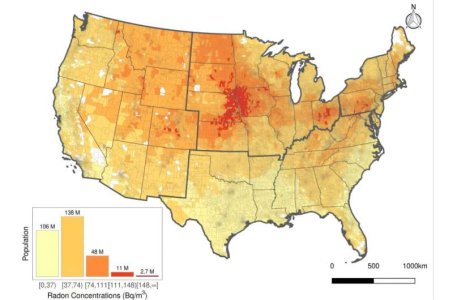Map reveals areas exposed to cancer-causing gas—is your home at risk?
By
Aubrey Razon
- Replies 0
As we grow older, hidden health risks become harder to ignore, and one silent threat may be closer than you think. A recent study reveals this danger could be affecting millions of homes across the country.
Could your home be at risk without you even knowing it?
Radon is a naturally occurring radioactive gas that you can't see, smell, or taste.
It's produced by the decay of uranium in soil and can be found in the air both indoors and outdoors.
The trouble with radon is that there's no safe level of exposure and it is linked to lung cancer.
When trapped inside homes, radon can reach harmful concentrations, especially in areas with high uranium content in the soil.

The Environmental Protection Agency (EPA) has set an “action level” of 148 Becquerels per cubic meter (Bq/m³) for radon.
At or above this level, the EPA recommends taking measures to reduce radon exposure due to the increased risk of lung cancer.
Researchers have now identified US regions where radon levels exceed the EPA's action level.
The Great Plains, particularly the borders of Iowa, Nebraska, and South Dakota, show the highest concentrations.
However, the study also found that over 83 million Americans live in homes with high radon levels, even in areas typically considered low-risk.
The study, which analyzed six million indoor radon measurements from 2001 to 2021, used a machine learning model to estimate radon concentrations.
It considered factors like geology, weather, building architecture, and socioeconomic status.
The resulting maps are a wake-up call for many, highlighting the need for widespread radon testing and mitigation.
Interestingly, the study noted significant seasonal differences in radon levels.
During the winter months, when homes are sealed tight to conserve heat, radon concentrations can spike.

This is particularly true in northwestern Kansas, eastern Nebraska, South Dakota, southern Minnesota, Iowa, North Dakota, and parts of Montana, Idaho, Wyoming, Colorado, Ohio, and Pennsylvania.
In winter, an estimated 9.7 million Americans live in areas where radon levels are above the EPA's action level, compared to just 120,000 in the summer.
This seasonal variation underscores the importance of testing for radon at different times of the year.
If you're among the millions potentially affected, there are steps you can take.
The EPA suggests sealing gaps in your home's foundation, walls, and floors, adding ventilation to crawl spaces, and improving indoor air circulation.
Even if radon levels in your home are detected as low as 75 Bq/m³, it's recommended to take action.
The high-resolution radon maps created by the researchers are tools for governments to refine regulations and for individuals to assess their risk.
Testing for radon is the only way to know if your home is affected, and home test kits are readily available.
Remember, knowledge is power, especially when it comes to our health. By staying informed and proactive, we can protect ourselves and our families from the dangers of radon.
Let's breathe easier knowing we're taking the right steps to safeguard our well-being.
 Have you tested your home for radon? Share your experiences in the comments below.
Have you tested your home for radon? Share your experiences in the comments below.
Could your home be at risk without you even knowing it?
Radon is a naturally occurring radioactive gas that you can't see, smell, or taste.
It's produced by the decay of uranium in soil and can be found in the air both indoors and outdoors.
The trouble with radon is that there's no safe level of exposure and it is linked to lung cancer.
When trapped inside homes, radon can reach harmful concentrations, especially in areas with high uranium content in the soil.

A new map identifies US hotspots where radon levels exceed the Environmental Protection Agency's (EPA) “action level”. Image source: Jessica Bryant/Pexels.
The Environmental Protection Agency (EPA) has set an “action level” of 148 Becquerels per cubic meter (Bq/m³) for radon.
At or above this level, the EPA recommends taking measures to reduce radon exposure due to the increased risk of lung cancer.
Researchers have now identified US regions where radon levels exceed the EPA's action level.
The Great Plains, particularly the borders of Iowa, Nebraska, and South Dakota, show the highest concentrations.
However, the study also found that over 83 million Americans live in homes with high radon levels, even in areas typically considered low-risk.
The study, which analyzed six million indoor radon measurements from 2001 to 2021, used a machine learning model to estimate radon concentrations.
It considered factors like geology, weather, building architecture, and socioeconomic status.
The resulting maps are a wake-up call for many, highlighting the need for widespread radon testing and mitigation.
Interestingly, the study noted significant seasonal differences in radon levels.
During the winter months, when homes are sealed tight to conserve heat, radon concentrations can spike.

Radon is a colorless, odorless radioactive gas deriving from the natural decay of uranium in soil. Image source: phys.org and Environmental Protection Agency (EPA).
This is particularly true in northwestern Kansas, eastern Nebraska, South Dakota, southern Minnesota, Iowa, North Dakota, and parts of Montana, Idaho, Wyoming, Colorado, Ohio, and Pennsylvania.
In winter, an estimated 9.7 million Americans live in areas where radon levels are above the EPA's action level, compared to just 120,000 in the summer.
This seasonal variation underscores the importance of testing for radon at different times of the year.
If you're among the millions potentially affected, there are steps you can take.
The EPA suggests sealing gaps in your home's foundation, walls, and floors, adding ventilation to crawl spaces, and improving indoor air circulation.
Even if radon levels in your home are detected as low as 75 Bq/m³, it's recommended to take action.
The high-resolution radon maps created by the researchers are tools for governments to refine regulations and for individuals to assess their risk.
Testing for radon is the only way to know if your home is affected, and home test kits are readily available.
Remember, knowledge is power, especially when it comes to our health. By staying informed and proactive, we can protect ourselves and our families from the dangers of radon.
Let's breathe easier knowing we're taking the right steps to safeguard our well-being.
Key Takeaways
- A new map identifies US hotspots where radon levels exceed the Environmental Protection Agency's (EPA) “action level”, potentially affecting up to 25% of Americans.
- Radon is a colorless, odorless radioactive gas deriving from the natural decay of uranium in soil, with no known safe exposure level, and linked to lung cancer.
- The Great Plains region has the highest radon levels, with considerable variation detected between winter and summer months; more Americans are at risk during the colder season.
- The EPA recommends action to reduce radon levels even for concentrations as low as 75 Bq/m³, and the study's detailed radon maps can aid in designing and improving health regulation and public understanding.






